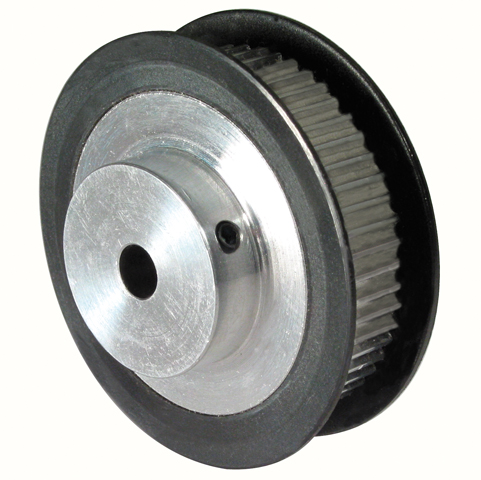Synchronous Pulleys Synchronous Pulley parts improve performance of motor-driven systems, increasing energy efficiency and lowering maintenance costs. Synchronous drive enables adjustment of velocity and torque while connecting mechanically rotating elements; belts and pulleys utilize teeth to prevent slippage and undesired speed variations.
Features
You can expect three types of molded Synchronous Pulleys to meet up the low-cost requirements in office automation gear and space-saving automated equipment
Synchronous Pulley S (sintered metal)
Synchronous Pulley D (aluminum, zinc die cast)
Synchronous Pulley MT (resin injection)
pplications/specifications
Lightweight and cost-effective use in workplace and automated equipment
Synchronous Pulleys
Description: These are toothed pulleys that transmit power through positive engagement between your pulley teeth and sprocket grooves rather than friction used in regular belts. They use the tooth-grip basic principle where square, circular, or altered curvilinear pulley teeth mesh with properly timed grooves on a drive for positive power transmission. As the pulley maintains positive engagement with the driving gear sprocket, power tranny is smooth. For instance, you do not have to get worried about the pulley slipping over the way it happens with standard belt drives. In addition, the thin cross section of synchronous pulleys means that less energy is needed to operate it. On crucial drives, utilizing a synchronous pulley that does not need retensioning can help improve your systems energy performance. It also really helps to reduce downtime. This will help to increase the overall production. Another benefit of using synchronous pulleys is usually that they allow one’s body to operate under various speeds, loads, and frequent starts. Nevertheless, it is necessary to ensure that your machine is certainly maintained at top condition for optimal performance. If installed properly, you are assured of high mechanical effectiveness. Synchronous pulleys can deliver as high as 98% efficiency when installed correctly. That is higher than the common V-belts that provide an average efficiency of 96%. However, it is necessary to appreciate that synchronous 
SYNCHRONOUS PULLEY
Ever-power’s SYNCHRONOUS pulleys are available for nearly every shaft diameter in relation to number of the teeth as well as to the profile chosen. They provide the option of non-positive or positive connections to the shaft using a clamping screw, keyway or conical clamping sleeve. MISUMI offers timing pulleys in aluminium or steel versions.
Ever-power offers a big selection of various timing pulleys
From various materials: Aluminium, metal (1.1191/C45Electronic) and stainless (1.4301)
Different profile shapes (MXL, XL, L, H, GT, YU, T and AT)
With additional surface treatment: anodized, clear or black, chemically nickel-plated and burnished
In disc form ?Form A? and offset hub ?Form B?
With individually configurable shaft diameters for many sizes
Ever-power synchronous pulleys are manufactured from high quality iron (GG25), tolerate shock loading and achieve rim speeds as high as 40m/s. Offered with pilot bore fixings or using the Ever-power shaft fixing system for ultimate versatility.
Available in both classical Timing and HTD profiles
Statically balanced to exceed grade G 6.3 (ISO 1940)
Rim boosts to no more than 40m/s
Blackened to reduce corrosion, acts as a perfect primer and removes the necessity for cleaning coating brokers prior to installation.
Precision machined grooves to protect and maximise belt existence whilst reducing noise
Ever-power mounting, for simple and quick installation
Unique designs and sizes available
Synchronous pulley
Technical Data
aluminium, anodized Electronic6/EV1
Housing from profile 45 x 90
Sprocket galvanized steel, ready for installation
maximum weight of the lifting door with paired insertion of the pulley, 34kg
weight = 0.340 kg/piece